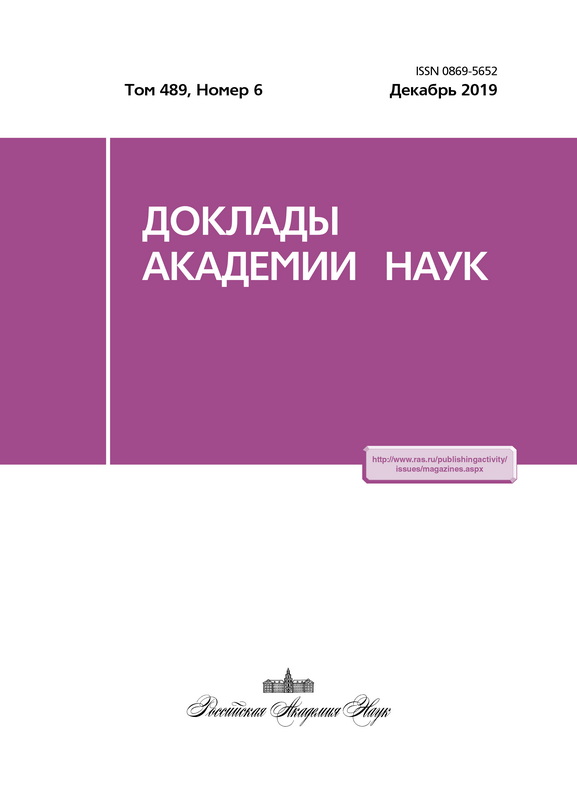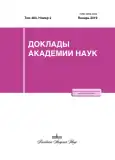Dynamics of intravital concentration of amino acid metabolites in human brain in post-traumatic period
- Authors: Semenova N.A.1,2,3, Menshchikov P.E.1,2,3, Manzhurtsev A.V.1,2, Ublinskiy M.V.1,3, Akhadov T.A.3, Varfolomeev S.D.1,4
-
Affiliations:
- Institute of Biochemical Physics of the Russian Academy of Sciences
- Institute of Chemical Physics of the Russian Academy of Sciences
- Clinical and Research Institute of Emergency Pediatric Surgery and Trauma
- Lomonosov Moscow State University
- Issue: Vol 484, No 2 (2019)
- Pages: 238-242
- Section: Biochemistry, biophysics, molecular biology
- URL: https://journals.eco-vector.com/0869-5652/article/view/11737
- DOI: https://doi.org/10.31857/S0869-56524842238-242
- ID: 11737
Cite item
Abstract
Intracellular concentrations of N acetyaspartate (NAA), aspartate (Asp) and glutamate (Glu) were determined for the first time in human brain in vivo, and the effect of severe traumatic brain injury on NAA synthesis in acute and late post-traumatic period was investigated. In MRI‑negative frontal lobes one day after injury Asp and Glu levels were found to decrease by 45 and 35%, respectively, while NAA level decreased by only 16%. A negative correlation between NAA concentration and the ratio of Asp/Glu concentrations was found. In the long-term period, Glu level returned to normal, Asp level remained below normal by 60%, NAA level was reduced by 65% relative to normal, and Asp/Glu ratio significantly decreased. The obtained results revealed leading role of the neuronal aspartate-malate shuttle in violation of NAA synthesis.
Full Text
About the authors
N. A. Semenova
Institute of Biochemical Physics of the Russian Academy of Sciences; Institute of Chemical Physics of the Russian Academy of Sciences; Clinical and Research Institute of Emergency Pediatric Surgery and Trauma
Email: andrey.man.93@gmail.com
Russian Federation, 4, Kosygina street, Moscow, 119991; 20 Bolshaya Polyanka Street, Moscow, 119180
P. E. Menshchikov
Institute of Biochemical Physics of the Russian Academy of Sciences; Institute of Chemical Physics of the Russian Academy of Sciences; Clinical and Research Institute of Emergency Pediatric Surgery and Trauma
Email: andrey.man.93@gmail.com
Russian Federation, 4, Kosygina street, Moscow, 119991; 20 Bolshaya Polyanka Street, Moscow, 119180
A. V. Manzhurtsev
Institute of Biochemical Physics of the Russian Academy of Sciences; Institute of Chemical Physics of the Russian Academy of Sciences
Author for correspondence.
Email: andrey.man.93@gmail.com
Russian Federation, 4, Kosygina street, Moscow, 119991
M. V. Ublinskiy
Institute of Biochemical Physics of the Russian Academy of Sciences; Clinical and Research Institute of Emergency Pediatric Surgery and Trauma
Email: andrey.man.93@gmail.com
Russian Federation, 4, Kosygina street, Moscow, 119991; 20 Bolshaya Polyanka Street, Moscow, 119180
T. A. Akhadov
Clinical and Research Institute of Emergency Pediatric Surgery and Trauma
Email: andrey.man.93@gmail.com
Russian Federation, 20 Bolshaya Polyanka Street, Moscow, 119180
S. D. Varfolomeev
Institute of Biochemical Physics of the Russian Academy of Sciences; Lomonosov Moscow State University
Email: andrey.man.93@gmail.com
Сorresponding Member of the RAS
Russian Federation, 4, Kosygina street, Moscow, 119991; 1, Leninskie gory, Moscow, 119991References
- Tallan H.H. // J. Boil. Chem. 1957. V. 224. P. 41–45.
- Moffett J., Ross B., Arun P., Madhavarao C., Nam-boodiri M. // Prog. Neurobiol. 2007. V. 81. № 2. P. 89–131.
- Moffett J., Arun P., Ariyannur P., Namboodiri A. // Front Neuroenergetics. 2013. V. 5. P. 1–19.
- Семенова Н.А., Луковенков А.В., Ахадов Т.А., Сидорин С.С., Варфоломеев С.Д. // Биохимия. 2012. Т. 77. № 4. С. 495–502.
- Moffet J., Arun P., Ariyannur P. Garbern J., Jacobo-witz D., Namboodiri A. // Glia. 2011. V. 59. № 10. P. 1414–1419.
- Kots E.D., Lushchekina S.V., Varfolomeev S.D., Nemukhin A.V. // J. Chem. Inf. Model. 2017. V. 57. № 8. P. 1999–2008.
- Vagnozzi R., Tavazzi B., Signoretti S., Amorini A.M., Belli A., Cimatti M., Delfini R., Di Pietro V., Fi-noc-chiaro A., Lazzarino G. // Neurosurgery. 2007. V. 61. № 2. P. 379–388.
- Harris J., Ye H., Choi I., Lee P., Berman N., Swerd-low R., Craciunas S., Brooks W. // J. Cereb. Blood Flow Metab. 2012. V. 32. P. 2122–2134.
- Kinoshita Y., A. Yokota A. // NMR Biomed. 1997. V. 10. № 1. P. 2–12.
- Mescher M., Merkle H., Kirsch J., Garwood M., Gruetter R. // NMR Biomed. 1998. V. 11. P. 266–272.
- Меньщиков П.Е., Семенова Н.А., Манжурцев А.В., Ахадов Т.А., Варфоломеев С.Д. // Изв. РАН. Сер. хим. 2018. № 4. С. 1–8.
- McKenna M., Waagepetersen H., Schousboe A., Sonnewald U. // Biochem. Pharmacol. 2006. V. 71. P. 399–407.
- La Noue K., Tischler M. // J. Biol. Chem. 1974. V. 249. P. 7522–7528.
- Jalil М., Begum L., Contreras L. // J. Biol. Chem. 2007. V. 280. P. 31333–31339.
- Di Pietro V., Amorini A., Tavazzi B., Vagnozzi R., Logan A., Lazzarino G., Signorett S., Lazzarino G., Belli A. // Mol. Med. 2014. V. 20. P. 147–157.
Supplementary files










